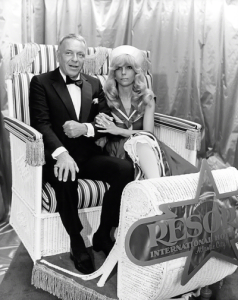When I think about the world of casino gambling, two notable motion pictures occur to my mind.
First, Martin Scorsese’s “Casino,” followed by Francis Ford Coppola’s “The Godfather.” Both films contain scenes of iconic dialogue that basically describe what this prosperous industry is comprised of: money, and entertainment. When I think of “Casino,” I think of Sam Rothstein’s (Robert DeNiro) intricate opening voiceover as to how the city of Las Vegas would bring in millions of gamblers each year, and then carefully fleece them of their well-earned dollars. When I think of “The Godfather,” I think of the scene where Michael Corleone (Al Pacino) speaks to Johnny Fontane (Al Martino) about his belief that having high-class entertainment in the casino showroom would be fruitful in drawing patrons into their gambling halls.
In terms of a gambling town like Las Vegas, it’s quite true that a city as such benefited generously from the introduction of gambling, and when it came to the entertainment that would tantalize the clientele, there was no higher brand or class of the medium then Francis Albert Sinatra.
There was another resort town, this one on the East Coast of the United States, and when gambling was officially legalized there in the late 1970s, it would successfully emulate the facets that made a resort like Las Vegas work. The town in question was Atlantic City, in Sinatra’s home state of New Jersey, and as its popularity as a burgeoning vacation destination grew, time would soon find the Chairman of the Board performing in several of the resort’s glitzy showrooms.
For the high rollers, and there were many, Sinatra was the top drawer.
Frank Sinatra was no stranger to Atlantic City. The town first became popular in the early twentieth century for its beautiful beaches and stately hotels. Several photographs have been published in recent years of Frank taking on the role of tourist and enjoying the beach with his family. When he began his professional career, among the places Sinatra would first work in the late 1930s and early 1940s would be Atlantic City’s Steel Pier, a major entertainment and amusement facility at the center of the boardwalk. Sinatra would share the stage of the pier’s ballroom with the likes of both Harry James and Tommy Dorsey, and these high-profile performances would both contribute to his growing popularity.
As the war-weary 1940s sped gracefully into the 1950s, Atlantic City would find itself transformed into one of the premier nightclub spots in the country, and every major Hollywood act would be appearing on one of the town’s stages at one time or another. Frank, in the same time, having transformed from big band boy singer to a successful solo performer, would find his way back to Atlantic City in the mid to late 1950s via his friend Paul “Skinny” D’Amato and D’Amato’s famous venue, the 500 Club.
A lifelong resident of Atlantic City, D’Amato was admittedly mob-connected, and the 500 Club served as a front for an illegal gambling operation. Located off the boards on Missouri Avenue, the club attained legendary status where the famous in all fields would mix, mingle and perform. Memorable Sinatra engagements include his appearance with the Red Norvo Quintet in 1959 as well as his own sextet fronted by pianist Bill Miller in 1960. Oft-seen photographs from one of these engagements depict a smiling, exuberant Sinatra on stage responding to comedian Joey Bishop’s heckling from off stage.
The 500 Club burned down in 1973, and some ten years later, when D’Amato succumbed to a heart attack in 1984, friend Sinatra would serve as one of his pallbearers.
Atlantic City, in the meantime, experienced an economic and social downturn as the 1960s progressed. With the jetliner increasing in popularity, allowing tourists to reach farther destinations in record times, the crowds that once dotted the Atlantic City boardwalk began to dissipate. Several of its once grand hotels and amusement piers fell into disrepair and ruin, and were subsequently demolished. Crime rose severely, and the once illustrious resort’s grand reputation seemed permanently tarnished.
A chance for a renaissance came in the form of a company known as Resorts International. Formed in 1968, their initiative was to bring gambling to the boardwalk. They would attempt this four times before gambling was officially legalized in New Jersey after the passing of a gaming referendum in late 1976. Despite the demolishing of several hotels along the boardwalk, a few of the original structures were still left standing. The company set their sights on the Haddon Hall, which had begun as a boarding house at the dawn of the century and had since transformed into a multi-story hotel. With extensive renovations made to accommodate a new casino as well as lavish new décor in both the rooms and throughout the building itself, the new Resorts International Hotel and Casino was prepped for opening at the end of May, 1978.
Several blocks north of Resorts International, the Caesars Corporation purchased the Howard Johnson Motor Lodge and they too began extensive renovations on the relatively new building with the intent of opening another casino. A large structure was added onto the existing building, and within two years, the Caesars Boardwalk Regency Hotel was opened to the public. It was the second casino on the boardwalk, christened nearly one year after Resorts, in June 1979.
In between these two properties, the truly ornate, twenties-vintage Marlborough-Blenheim Hotel was demolished by Bally Manufacturing to build a sprawling Park Place Casino. Taking the initiative from both Resorts and Caesars, Bally’s would utilize and renovate the closed Dennis Hotel next door to serve as their hotel wing while the casino would be housed in a new building on the site of the old Blenheim. Bally’s Park Place opened in December 1979.
It was then that the New Jersey State Government stepped in. Governor Brendan Byrne, appalled at what he perceived to be shoddy patch and paint jobs by these casino companies in order to get their gaming properties up and running, demanded that any new casino-hotels constructed within Atlantic City be completely built new from the ground up, with no use of older buildings. It would be the practice from then on.
Thus, the fourth casino opened in Atlantic City was housed in a completely new structure. Built on the site of a former hotel, the Brighton, the Greate Bay Casino Hotel (later renamed the Brighton in honor of the former property) consisted of a 21-story hotel tower with a 5-story podium housing the nearly 60,000 square foot casino. Opened in 1980, it was the first of modern skyscrapers that would begin to dot the Atlantic City skyline in the years to come.
Like the fictional Michael Corleone of “The Godfather,” property owners took their cue from Las Vegas and began to populate their new casinos with the finest in modern entertainment. The dollars came rolling through. Resorts International, being the first opened property on the boardwalk, soon snatched up Sinatra in a contract in which he would perform at the hotel’s Superstar Theatre for a number of years, beginning in 1979.
While several bootleg recordings of Sinatra performing at Resorts exist from the years he performed there (1979-1982), one in particular, which was seemingly recorded by the Sinatra camp for a possible future commercial release, features Frank in fine voice singing to a packed house in 1979. Among those in attendance include the other three members of the Hoboken Four (Sinatra’s hometown singing group he joined forty years before) as well as actor Burt Lancaster, Sinatra’s co-star in “From Here To Eternity.” Lancaster was in town filming (with co-star Susan Sarandon) the notable coming of age film “Atlantic City,” directed by Louis Malle and released in 1980.
Sinatra mixes old and new in this concert, performing some of his classics while showcasing a series of new music (Sinatra was in the midst of recording his 1980 “Trilogy” album and decided to bring a series of charts from the album with him to build anticipation for the forthcoming record set). Although not officially released by the Sinatra estate, the recording makes its rounds under the titles “It’s Showtime!” and “For The Good Times” on the private circuit, and is prized by Sinatra fans and music collectors alike.
Things were going very well in Atlantic City, and when it was announced that Sinatra would be appearing in town, Resorts International would be sure to make out well, due to the showroom being filled to capacity for each performance.
Soon enough, however, gambling magnate and Sinatra friend Steve Wynn was about to set his sights on Atlantic City, and would take the town, as well as the level of luxury and accommodation to a whole new level.
To be continued…
Until next time, Sinatra lovers!
Jerry Pearce is an amateur singer in the vein of Frank Sinatra, Perry Como, and Dick Haymes and has released two discs of standards music, Crossroads in 2010, and One Summer Night in 2016. Samples of his music can be heard on his YouTube Channel. To purchase his CDs use the form box below.
[si-contact-form form=’3′]

 June 20th, 2016
June 20th, 2016  CEO
CEO 
 Posted in
Posted in  Tags:
Tags: 



